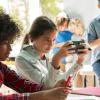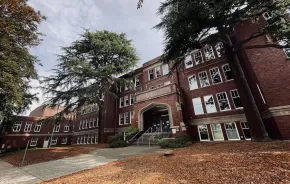
In the movie Clueless, Alicia Silverstone’s shallow, shopaholic character Cher is assigned to debate a classmate on the merits of allowing Haitian refugees into the U.S. Though her arguments in favor of immigration are unorthodox (she likens allowing refugees into the country to allowing guests to crash a party), Cher’s passion inspires her previously disinterested high school classmates to rally around her cause. Her opponent is too overwhelmed to offer a rebuttal.
That’s the power of healthy debate —the ability to make people care.
Debate team 2.0
Thanks in part to technology, the high school debate experience has come a long way from stiff, awkward exchanges behind podiums, with hand trucks full of supporting documents. Today’s debate teams carry their evidence on laptops, use Smartphone apps to select topics and time their competitions and Skype to interact.
Joel Underwood is the speech and debate coach at Seattle Academy, an independent school in Seattle serving students in grades 6-12. He’s also chair of the school’s Department of Rhetoric, which includes other activities that have speaking and presentation components, such as Model United Nations and the mock trial program.
Of these expository activities, Underwood says speech and debate is the most nationally and internationally pervasive, with a strong infrastructure and a rich history, dating back to the post-World War II era.
But, says Underwood, while debate teams of yore had to carry piles of paper evidence with them to competitions, for today’s team, the evidence they need is just a keystroke away, stored on their laptops. Unlike a basketball team, which needs a gym to compete, the debate team is mobile, says Underwood, able to compete anywhere.
SAAS’s speech and debate team, which last year comprised 60 members, has won nine state debate titles since 2000 (including seven consecutive awards), along with 22 individual event state titles and a national expository championship in 2011. Underwood credits his program’s success to a combination of talented kids and a supportive school administration.
SAAS students can take debate as a class for credit or as an extracurricular activity. Both options enable students to participate in competitions around the U.S.
Underwood also teaches speech to 7th and 8th-graders. Though there are middle school debate competitions, he feels strongly that middle school is a time to build a foundation in debate, focusing on skill development rather than competition.
It’s a small word, after all
Some organizations are fostering and facilitating debate activities around the globe. The International Debate Education Association (IDEA) is a global network that provides resources, training and events for educators and students and partners with foundations, non-governmental organizations, businesses and governments.
In early 2014, TED-Ed, the education arm of the popular idea-sharing global platform, launched TED-Ed clubs, a classroom-based initiative to teach students presentation skills. This free program was piloted in over 100 schools worldwide in 2013 and received 1,000 club applications when the program officially launched last January.
TED-Ed club participants learn to present their ideas to their peers around the world in TED-style talks. Teachers can nominate student presentations to be featured at a TED event. Participants say one of the biggest benefits of the program is that students learn to overcome stage fright.
Scarier than death
In a 2011 Gallup poll about fear, Underwood says public speaking ranked higher than death.
The future will always belong to people who can get up in front of folks and present their ideas.
“There is a significant chunk of people walking the planet who would rather die than speak publicly,” he jokes. But Underwood sees the need for effective communication as no laughing matter.
Underwood recommends that parents understand that every kid is on a different journey when it comes to public speaking. He advises parents to be comfortable with their children’s starting level and also comfortable with where they end up.
If your child is anxious about public speaking, let him or her lead the process and resist the urge to help. For example, if your child has to do an oral presentation for school, you can offer to help and offer to serve as an audience. But if the child balks, respect that decision, remembering that it can be far more intimidating to speak in front of family than in front of classmates or strangers.
Most important — don’t let your child’s protests prevent him or her from gaining public speaking experience.
“In some way, every student should participate in some form of public speaking before they graduate from high school — a youth legislative program, Model United Nations, or something,” recommends Underwood. “Everybody should have to do some facet of public presentation. It will make all the difference for success.”
Similarly, don’t assume that because your child interests and strengths are more solitary, introspective or technical, public speaking is not a priority.
“You can code your butt off,” says Underwood, “but the people who run the show are those who can express themselves.”
Bridging the gap
“Debate and forensic speaking translate to any career anyone would ever choose,” says John Julian, a systems engineer who has coached debate teams for the past 25 years. “There is not a single job that doesn’t require you to speak and interact with people.”
In addition to presentation skills, speech and debate clubs teach students active listening skills and how to analyze what others are saying. They also teach students how to speak extemporaneously, a useful skill if, for example, you are called in to meet with the CEO to justify project funding.
Underwood imagines a roomful of scientists seeking research funding to beat cancer or the Ebola virus, having to make their case before a group of venture capitalists. Lives will depend on their ability to effectively make their case.
“You can be smartest guy in the room, but if you can’t communicate and get people excited, you will fail to persuade them,” he cautions.
Because he views bridging the knowledge/communications gap as the next frontier, Underwood is developing a scientific communication class, to eventually be offered to SAAS seniors. They will be expected to develop a science project and then pitch it to potential donors. Key skills he hopes to impart are learning to shorten presentations and effectively use metaphors.
“Speech and communication are a means to an end,” he says.
“Being able to think quickly, organize your thoughts and impress the heck out of everyone are great tools to have in your bag,” Julian adds.
What the future holds
There is no single activity better for your child’s continuing education than speech and debate, Underwood says. It teaches organization, structure, research and confidence.
It also contributes to civic health.
“When we involve students in debating issues that really matter to them and they see the power of their voices and ideas, we not only facilitate their development of critical academic and life skills, we boost their efficacy and our community civic health,” says Diane Douglas, executive director of Seattle City Club, an organization that encourages exploration of diverse perspectives on issues vital to our region.
Where can you find the leaders of tomorrow? In How To Find The Millennials Who Will Lead Your Company, a March 2014 feature in Forbes, the answer is clear: at speech and debate competitions.
Underwood cites a Princeton Review survey of extracurricular activities and how they correlate to college admission and success.
Speech and debate ranked no. 1.
Yet Underwood is concerned that speech and debate often get short shrift, as schools set their budget priorities.
Like any competitive activity that requires transportation, debate can be expensive, he admits, but Skype can be an asset.
In the growing movement to link educational outcomes to a direct tie-in with jobs, especially in the STEM (science, technology, engineering and math) fields, Underwood worries that schools will see speech and debate as luxuries, instead of essential tools for success in any career.
“I don’t want this to become a matter of privilege, in which only wealthy schools and independent schools can provide communications opportunities for their students,” he says.
Julian thinks one solution is the localization of speech and debate events and growth of regional speech and debate communities. On the Eastside, teams have grown and are spreading from Bellevue to Redmond to Woodinville and beyond.
He’s been working with the National Speech and Debate Association on creative ways that established debate clubs could mentor fledging organizations. The more teams in one region, the more possibilities for local competitions, which can cut down on expensive travel.
The association offers online debate camps — a cost-effective way for students, especially those in rural areas, to receive coaching.
The more opportunities to expand the reach of forensic speaking, the better, say these experts.
“So many careers rely on communications skills,” Underwood says. “The future will always belong to people who can get up in front of folks and present their ideas.”











